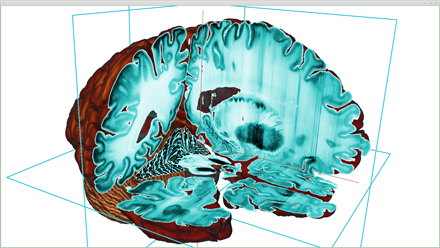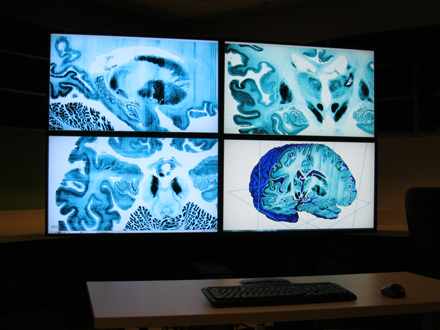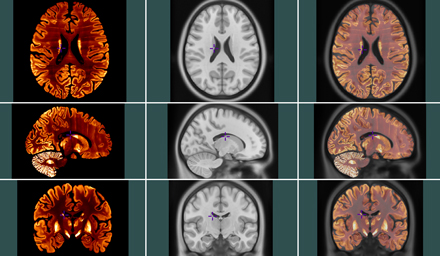
By Anita Kar
Imagine being able to zoom into the brain to see various cells the way we zoom into Google maps of the world to look at houses on a street. Although the brain is considered the most complex structure in the universe with 86 billion neurons, zooming in on it is now possible thanks to a new brain atlas with unprecedented resolution.
BigBrain is the first 3D microstructural model of the entire human brain, and is free and publicly available to researchers world-wide. The results of the BigBrain model, created at the Montreal Neurological Institute and Hospital of the McGill University Health Centre in collaboration with researchers at Forschungszentrum Jülich, Germany, are published in the June 20 issue of Science.

“The BigBrain atlas offers nearly cellular resolution, that is detail close to the level of the cell, a capability that has not been previously available in 3D for the human brain,” says Dr. Alan Evans, researcher at The Neuro, co-founder of the International Consortium for Brain Mapping and co-creator of the atlas. “To put BigBrain in context, we can consider present day MRIs which have a 3D spatial resolution of 1mm. In comparison, the BigBrain data set is 50 times smaller in each dimension providing unmatched spatial resolution. The BigBrain data set is 125,000 times (50 x50 x 50) bigger than a typical MRI, and has a volume of 1 terabyte, which is equal to 1000 GB.”
Researchers world-wide will be able to download brain sections from the BigBrain website bigbrain.loris.ca. Big Brain is reconstructed from 7,404 histological brain sections which were stained for cell bodies, and then digitized, taking advantage of recent progress in computing capacities, brain images analysis, and the teams’ experience in processing complete histological sections of the brain.
The advance in resolution is analogous to the transition from older line maps to Google satellite images. Zooming into older maps provides no more detail or information. Similarly, zooming into an MRI scan provides no further detail – it just reveals the blocky 1mm pixellation. The BigBrain brain atlas is the equivalent of Google street view, zooming in provides a new level of information that hasn’t been offered before in 3D.

Current atlases based on histological slices are in 2D. BigBrain redefines these traditional neuroanatomy maps such as those of Brodmann by providing an ultra-view of the brain using fully automated 3D techniques. Atlases based on MRIs do not allow for the integration of information at the level of cortical layers, columns, micro circuits, or the larger cells. BigBrain enables researchers to see at 20 micron resolution (1,000 microns in a millimetre) throughout the brain.
The implications of BigBrain to explore and analyze the human brain are innumerable. It can be used to integrate and correlate data from a wide range of modalities: genetic, molecular neuroscience, electrophysiological and pharmacological among many. It will enable and accelerate computational modelling for simulation of brain functions, normal development and degeneration caused by disease.
BigBrain will vastly improve the importance and interpretation of low-resolution dynamic in-vivo data obtained by MRI and PET, by combining the data with the enormous detail and spatial resolution of the static BigBrain atlas. It will enhance neurosurgical procedures, for example placing deep brain stimulators and will advance clinical research, for example, localizing the site of intractable epilepsy to certain specific type of nerve cells.

SCIENCE. IS. AMAZING.
I was wondering if brain mapping could be used for surgery for Basilar Invagination. My handicapped daughter has it and we are searching for,the easiest,less trauma surgery. We have found UPMC in Pittsburg,Pa. That does surgery via the nose. I was wondering if this could be used as an aide to this type of surgery. She is e everything to us and we have been searching for answers since we discovered she has this. We never heard of it before,and it absolutely frightens us.
Okay, this is great! but where can I download the program to view this bad boy? I realize my computer doesn’t have a terrabyte of dataspace but that isn’t how google earth works. Google servers render and transmit the image data I want to conjure by using their software, google Earth. I suspect they don’t have the server capacities of google – who does? Must I be a neural scientist with special research privileges to view this Gordian knot?
It is amazing and disorienting the sheer amount of information one can access with this system. But i wonder: if this is a 3D scan of one single human brain, is its structure (in such a deep detail) being maintained throughout the average human brain people possess?
We have an atlas, that is wonderful. But what about the needle in the haystack in that atlas? Is there reason to hope this will speed up research findings and results? Autism advancement?
i think that this is a good step forward for brain research, thank you,
I believe that brain research is going to solve great problems of human life like curing of some diseases. Human society is wait hopefully. But I think brain research is close to another revolution in learning. I gonna give an example. Assume that you want to learn a new language. It will be possible just in a few days!!! You just need a small surgery to plant a nano-size electronic device (electronic memory) that involves an information package about the desired language. The brain will read this package (like reading a flash memory by a computer), … , and as… Read more »
This great! I find it two ways; both as science personnel interested in research and for the treatment of my child having probably CSF leakage from her ear the pathway of which has yet not been established. Shall be great to hear details in these connections.
Great ! The brain is still the most unknown organ of human body. It’s complexity is the reason. But also prejudice. Catholic church in the 40’s was against researchs concerning pain. People had to suffer and struggle, was the idea…
Know it’s parts in detail is just the begining of a series of future discoveries.
beautiful work !
There are a number of CAD (Computer-Aided Design) and CADD (Computer-Aided Design and Drafting) software visualization programs that can manipulate 3-D data in virtual 3-and 4-dimensional space. These programs have been used in manufacturing and research for several decades and it should not be difficult to utilize them on the BigBrain dataset. Here is an example of a free, open source 3-D visualization package called “Visualization Tool Kit”: http://www.vtk.org/ , and, for the record, I am not in any way connected with this developer, or even the industry.
It’s a no-brainer.